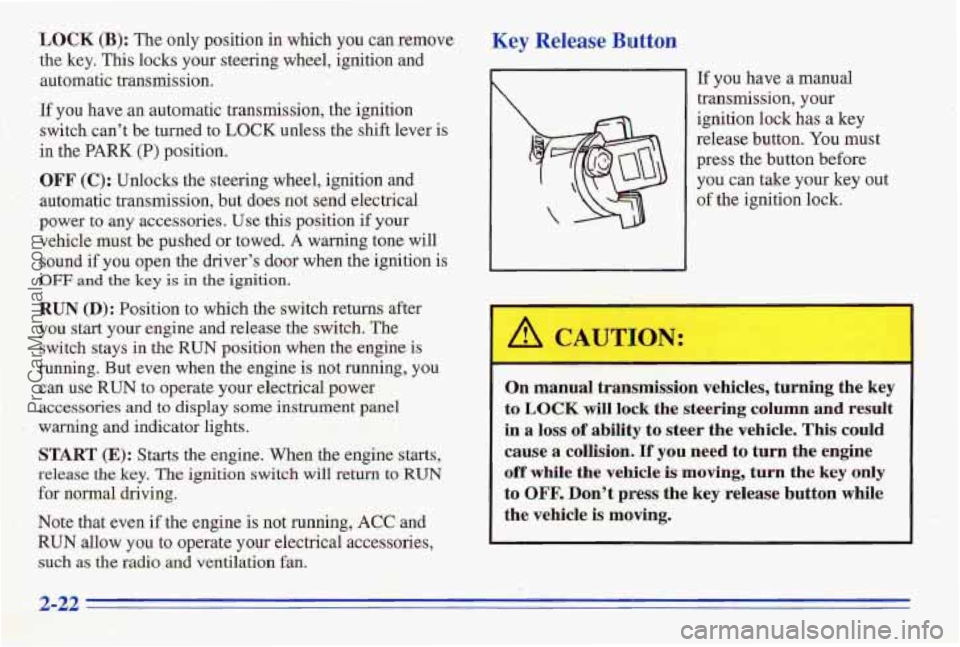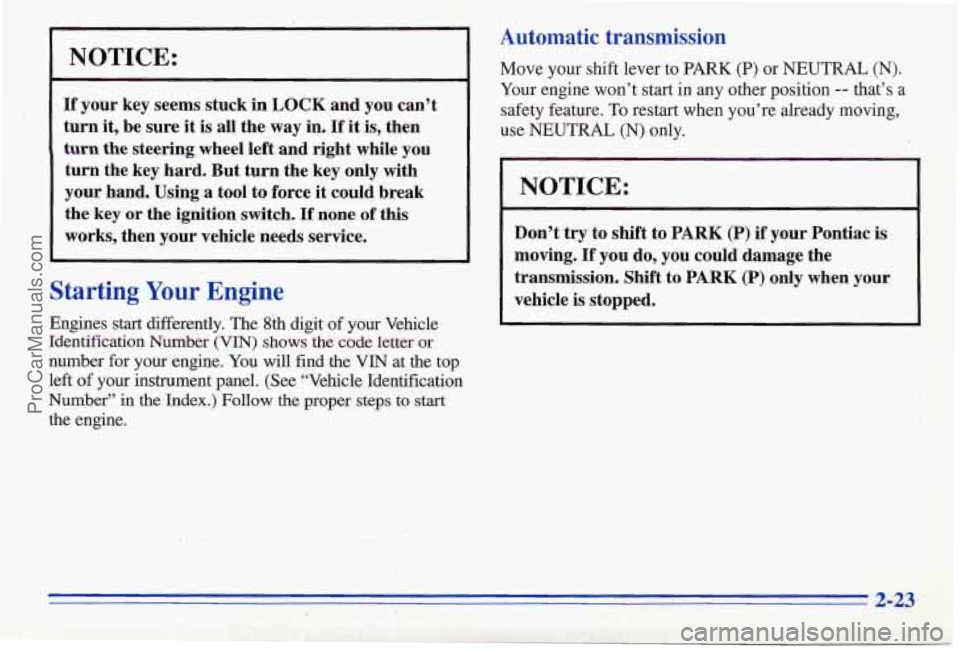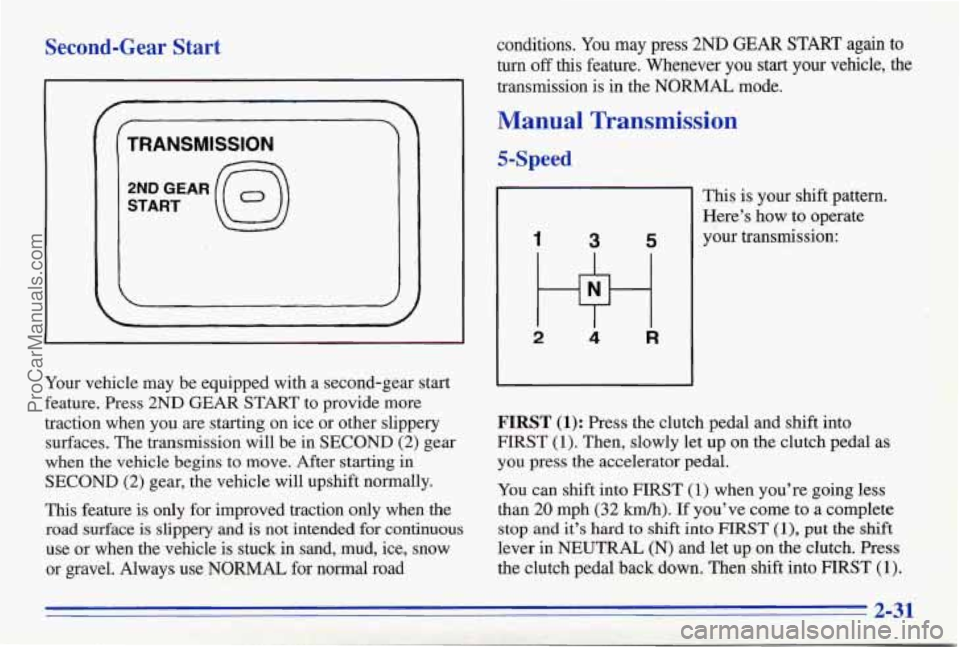PONTIAC FIREBIRD 1996 Manual PDF
Manufacturer: PONTIAC, Model Year: 1996, Model line: FIREBIRD, Model: PONTIAC FIREBIRD 1996Pages: 386, PDF Size: 19.18 MB
Page 71 of 386

LOCK (B): The only position in which you can remove
the key.
This locks your steering wheel, ignition and
automatic transmission.
If you have an automatic transmission, the ignition
switch can't be turned to
LOCK unless the shift lever is
in the PARK (P) position.
OFF (C): Unlocks the steering wheel, ignition and
automatic transmission, but does not
send electrical
power
to any accessories. Use this position if your
vehicle must be plashed or towed. A warning tone will
sound
if you open the driver's door when the ignition is
OFF and the key is in the ignition.
RUN (D): Position to which the switch returns after
you start your engine and release. the switch. The
switch stays in
the RUN position when the engine is
running. But even when the engine is not running, you
can use RUN to operate your electrical power
accessories and to display some instrument panel
START (E): Starts the engine. When the engine starts,
release the key. The ignition switch will return to RUN
for normal driving.
Note that even if the engine is not running,
ACC and
RUN allow you to operate your electrical accessories,
such as the radio .and ventilation fan.
I warning and indicator lights.
Key Release Button
If you have a manual
transmission, your
ignition lock has
a key
release button. You
must
press the button before
you can take your key out
of the ignition lock.
On manual transmission vehicles, turning the key
to
LOCK will lock the steering column and result
in a loss of ability to steer the vehicle. This could
cause a
collision. If you need to turn the engine
off while the vehicle is moving, turn the key only
to OFF. Don't press the key release button while
the vehicle
is moving.
ProCarManuals.com
Page 72 of 386

NOTICE:
If your key seems stuck in LOCK and you can’t
turn
it, be sure it is all the way in. If it is, then
turn the steering wheel left and right while you
turn the key hard. But turn the key only with
your hand. Using
a tool to force it could break
the key or the ignition switch.
If none of this
works, then your vehicle needs service.
Starting Your Engine
Engines start differently. The 8th digit of your Vehicle
Identification Number
(VIN) shows the code letter or
number for your engine. You will
find the VIN at the top
left of your instnzment panel. (See “Vehicle Identification
Number” in the Index.) Follow
the proper steps to start
the engine.
Automatic transmission
Move your shift lever to PARK (P) or NEUTRAL (N).
Your engine won’t start in any other position -- that’s a
safety feature. To restart when you’re already moving,
use NEUTRAL
(N) only.
NOTICE:
Don’t try to shift to PARK (P) if your Pontiac is
moving. If you do, you could damage the
transmission. Shift to PARK
(P) only when your
vehicle
is stopped.
2-23
ProCarManuals.com
Page 73 of 386

Manual transmission
The gear selector should be in NEUTRAL (N).’Hold the
clutch pedal to the floor and start the engine. Your
vehicle won’t start
if the clutch pedal is not all the way
down
-- that’s a safety feature.
Starting Your 3800 Engine
1. Without pushing the accelerator pedal, turn your
ignition key to START. When the engine starts, let
go of the key. The idle speed will go down as your
engine gets
warm.
NOTICE:
Holding your key in START for longer than
15 seconds at a time will cause your battery to be
drained much sooner.
And the excessive heat can
damage your starter motor.
2. If it doesn’t start right away, hold your key in
START for about three to five seconds at a time until
your engine starts. Wait about
15 seconds between
each try to help avoid draining your battery.
3. If your engine still won’t start (or starts but then
stops), it could be flooded with too much gasoline.
Try pushing your accelerator pedal all the way to the
floor and holding
it there as you hold the key in
START for about three seconds. If the vehicle starts
briefly but then stops again, do the same thing, but
this time keep the’ pedal down for five or six seconds.
This clears the extra gasoline
from the engine.
After waiting about
15 seconds, repeat the normal
starting procedure.
NOTICE:
Your engine is designed to work with the
electronics
in your vehicle. If you add electrical
parts or accessories, you could change the
way
the engine operates. Before .adding electrical
equipment, check with your dealer.
If you don’t,
your engine might not perform properly.
If you ever have to have your vehicle towed, see
the part
of this manual that tells how to do it
without damaging
your vehicle. I See c6To~g
Your Vehicle” in the Index.
2-24
ProCarManuals.com
Page 74 of 386

Starting Your 5.7 Liter LT1 Engine
1. Without pushing the accelerator pedal, turn the
ignition key to START. When the engine starts,
let
go of the key. The idle speed will go down as your
engine gets warm.
NOTICE:
Holding your key in START for longer than
15 seconds at a time will cause your battery to be
drained much sooner. And the excessive heat can
damage your starter motor.
2. If it doesn't start wihn 10 seconds, push the
accelerator pedal
all the way to the floor, while you
hold the ignition key in START. When the engine
starts, let go of the key and let up on the accelerator
pedal. Wait about
15 seconds between each try to
help avoid draining your battery.
When starting your engine in very cold weather (below
0°F or -18"C), do this:
1. With your foot off the accelerator pedal, turn the
ignition key to START and hold it there. When the
engine starts,
let go of the key. Use the accelerator pedal
to maintain engine speed, if you have to, until
your engine
has run for a while.
stops), it could be flooded with too much gasoline.
Try pushing your accelerator pedal
all the way to the
floor and holding it there as you hold the key in
START for about three seconds. If the vehicle starts
briefly but then stops again, do the same thing, but
this time keep the pedal down for five or six seconds.
This clears the extra gasoline from the engine.
2. If your engine still won't start (or starts but then
I NOTICE:
Your engine is designed to work with the
electronics in your vehicle.
If you add electrical
parts or accepsories, you could change the
way
the engine operates. Before adding electrical
equipment, check with your dealer.
If you don't,
your engine might not perform properly.
If you ever have to have your vehicle towed, see
the part of this manual that tells how to do
it
without damaging your vehicle. See 4'Towing
Your Vehicle" in the Index.
2-25
ProCarManuals.com
Page 75 of 386

Engine Coolant Heater (Option)
[n very cold weather, 0°F (- 18 "C) or colder, the engine
coolant heater can help. You'll get easier starting and
better fuel economy during engine warm-up. Usually,
the coolant heater should be plugged in a minimum
of
four hours prior to starting your vehicle,
I'o Use the Coolant Heater
1. Turn off the engine.
2. Open the hood and unwrap the electrical cord.
3. Plug it into a normal, grounded 110-volt AC outlet.
P
A CAJT,,J:
Plugging the cord into an ungrounded outlet
coul'd cause an electrical shock. Also, the wrong
kind
of extension cord could overheat and cause
a
fire. You could be seriously injured. Plug the
cord into
a properly grounded three-prong
110-volt
AC outlet. If the cord won't reach, use a
heavy-duty three-prong extension cord rated for
at least 15 amps.
4. After you've used the coolant heater, be sure to
store the
cord as it was b'efore to keep it away
from moving engine
parts. If you don't, it could
be damaged.
How long should you keep the coolant heater plugged
in? The answer depends on the outside temperature,
the
kind of oil you have, and some other things. Instead of
trying to list everything here, we ask that you contact
your Pontiac dealer
in the area where you'll be puking
your vehicle. The dealer can give
you the best advice for
that particular area.
2-26
ProCarManuals.com
Page 76 of 386

Automatic Transmission Operation
There are several different positions for your shift lever.
PARK (P): This locks your rear wheels. It’s the best
position
to use when you start your engine because your
vehicle can’t move easily.
-
It is dangerous to get out of your vehicle if the
shift lever
is not fully in PARK (P) with the
parking brake firmly set. Your vehicle can roII.
Don’t leave your vehicle when the engine
is
running unless you have to. If you have left the
engine running, the vehicle can move suddenly.
You
or others could be injured. To be sure your
vehicle won’t
move, even when you’re on fairly
level ground, always set your parking brake and
move the shift lever to
PARK (P).
See “Shifting Into PARK (P)’% in the Index. If
you’re pulling a trailer, see “Towing a Trailer’’ in
the Index.
2-27
ProCarManuals.com
Page 77 of 386

Ensure the shift lever is fully in PARK (P) range
before starting the engine. Your Ponti’ac has
a
brake-transmission shift interlock. You have to fully
apply your regular brakes before you can shift from
PARK (P) when the ignition key is in the RUN position.
If YOU cannot shift out of PARK (P), ease pressure on
the shift lever -- push the shift lever all the way into
PARK (P) and also release the shZt lever button on floor
shift console models as you maintain brake application.
Then move
the shift lever into the gear you wish.
(Press the shift lever button before moving the shift
lever
on floor shift console models.) See “Shifting Out
of PARK” (P) in this section.
REVERSE (R): Use this gear to back up.
NOTICE:
Shifting to BEVERSE (R) while your vehicle
’is moving forward could damage your
transmission. Shift to
REVERSE (R) only
after
your vehicle is stopped,
To rock YOW vehicle back and f~~th to get out of snow, ice
or
sand without damaging your transmission, see “Stuck
In Sand, Mud, Ice or Snow, If You’re” -in the Index.
NEUTRAL (N): In this position, your engine doesn’t
connect with the wheels.
To restart when you’re
already moving, use NEUTRAL (N) only. Also, use
NEUTRAL (N) when your vehicle is being towed.
Shifting out of PARI( (B) or NEUTRAL (N) while
your engine
is “racing” (running at high speed) is
dangerous. Unless your foot is firmly on the
brake pedal,
your vehicle could move very
rapidly. You could
lose control and hit people or
objects, Don’t shift out ofPARK (P) or
NEUTBAL (N) while your engine is racing.
I NOTICE:
Damage to your transmission caused by shifting
out
of PARK (P) or NEUTRAL (N) with the
engine racing isn’t covered by your warranty.
ProCarManuals.com
Page 78 of 386

AUTOMATIC OVERDRIVE (@): This position is
for normal driving.
If you need more power for passing,
and you’re:
- Going less than about 35 mph (56 km/h), push your
- Going about 35 mph (56 km/h) or more, push the
accelerator pedal about halfway down.
accelerator all the way down.
You’ll shift down to the next gear and have
more power.
THIRD (3): This position is also used for normal
driving, however, it offers more power and lower
fuel
economy than AUTOMATIC OVERDRIVE (@),
Here are some times you might choose THIRD (3)
instead of AUTOMATIC OVERDRIVE (a):
- When driving on hilly, winding roads.
- When towing a trailer, so there is less shifting
- When going down a steep hill.
between gears.
SECOND (2): This
position gives you more power but
lower fuel economy. You can use
SECOND (2) on hills.
It can help control your speed as you
go down steep
mountain roads, but then you would also want
to use
your brakes
off and on.
NOTICE:
Don’t drive in SECOND (2) for more than 25 miles
(40 km), or at speeds over 55 mph (88 km/h),
or you can damage your transmission. Use
AUTOMATIC
OVERDRIVE (a) or THIRD (3)
as much as possible.
Don’t shift into SECOND (2) unless you are going
slower than 65 mph (105 M), or you can
damage your engine.
2-29
ProCarManuals.com
Page 79 of 386

FIRST.(l): This position gives you even more power
(but lower fuel economy)
than SECOND (2). You can
use it on very steep hiils,
or in deep snow or mud. If
the selector lever is put in FIRST (11, the transmission
won't
shift into first gear until the vehicle is going
slowly enough.
NOTICE:
I If your rear wheels can't rotate, don't try to, I..
NOTICE: (Continued)
Also,
if you stop when going uphill, don't hold
your vehicle there with
only the accelerator
pedal. This couEd overheat and damage the
transmission. Use your brakes
or shift into
PARK (P) to hold your vehicle in position on
a hill.
drive. This might happen if you were stuck
in- Maximum engine speed is limited to protect driveline
very deep sand or mud or were up agaht'a s&d
NOTICE: (Continued)
components from improper operation.
, object. You could damage your transmission.
2-30
ProCarManuals.com
Page 80 of 386

Second-Gear Start
TRANSMISSION
2NDGEARQ START
Your vehicle may be equipped with a second-gear start
feature. Press 2ND GEAR START to provide more
traction when you are starting on ice or other slippery
surfaces. The transmission will be in SECOND
(2) gear
when the vehicle begins to move. After starting
in
SECOND (2) gear, the vehicle will upshift normally.
This feature is only for improved traction only when the
road surface is slippery
and is not intended for continuous
use
or when the vehicle is stuck in sand, mud, ice, snow
or gravel. Always use NORMAL for normal road conditions.
You may press
2ND GEAR START again to
turn off this feature. Whenever you start your vehicle, the
transmission is in the NORMAL mode.
Manual Transmission
5-Speed
1 3 5
2 4 R
This is your shift pattern.
Here’s how to operate
your transmission:
FIRST (1): Press the clutch pedal and shift into
FIRST
(1). Then, slowly let up on the clutch pedal as
you press the accelerator pedaL
You can shift into FIRST
(1) when you’re going less
than 20 mph (32
km/h). If you’ve come to a complete
stop
and it’s hard to shift into FIRST (l), put the shift
lever
in NEUTRAL (N) and let up on the clutch. Press
the clutch pedal back down. Then shift into
FIRST (1).
2-31
., . ProCarManuals.com